#himitsu no arashi chan
Explore tagged Tumblr posts
Photo
I’m reblogging this again bc I couldn’t stop thinking about the Yama pair gif
I love Riida so much he’s such a socially inept little bean and I love him 😭😭😭💕💕💕


Before the draw I was wondering if Sakumoto would do it the way Yama did. Turned out they did exactly as expected </3
369 notes
·
View notes
Text
CHAMPIONS BRACKET‼️‼️‼️








It's here!
No losers bracket, if we die we die ✌
Polls will be up for a WEEK. Starting this Friday.
To browse polls without additions or see propaganda, you can find navigation tags in the pinned post.
Like with the underdogs bracket, these polls aren't going to have content warnings (though, I do plan on giving titles a little tagline).
Dates below are DD/MM and all times are in GMT.
A LOT... OF MATCHES UNDER THE CUT
SIDE A1 PART 1 || 17/01, 6PM
the guy she was interested in wasnt a guy at all VS himitsu no hanazono
blooming sequence VS sasameki koto
always human VS can i kiss you?
my girlfriend's not here today VS will we live happily ever after?
SIDE A1 PART 2 || 17/01, 6.30PM
yokohama kaidashi kikou VS pink ribbon
sukeban to tenkousei VS yuri espoir
serendipity VS sea of june
not so shoujo love story VS hana to hoshi
SIDE A2 PART 1 || 17/01, 7PM
handsome girl and sheltered girl VS "the villainess" and the woman who would do anything for the sake of love
mahou josei chimaka VS aoi hana
muted VS mai no mushigurashi
that time i was blackmailed by the class's green tea bitch VS murdist
SIDE A2 PART 2 || 17/01, 7.30PM
how do we relationship VS dark forest, white road
the two of them are pretty much like this VS i love you so much, i hate you
she loves to cook, and she loves to eat VS vengeance
otherside picnic VS only need to love once
SIDE B1 PART 1 || 19/01, 6PM
whisper me a love song VS marriage as friends
after hours VS the princess of sylph
i decided to fake a marriage with my junior to shut my parents up VS pieta
our yuri started with me getting rejected in a dream VS i'm not cut out to be a princess, so i'll elope with the villainess
SIDE B1 PART 2 || 19/01, 6.30PM
run away with me, girl VS indigo blue
yoru to umi VS a kiss for the girls' scars
this monster wants to eat me VS joshi-man
hello melancholic VS love/death
SIDE B2 PART 1 || 19/01, 7PM
tamen de gushi VS maria-sama ga miteru
to die in june VS composing spring in this room where cherry blossoms bloom
hana ni arashi VS yuki and the authoress
how do i get together with my childhood friend? VS iberis no hanayome
SIDE B2 PART 2 || 19/01, 7.30PM
hard lacquer VS moonlight flowers
even though we're adults VS black & white
asumi-chan is interested in lesbian brothels VS yuri kuma arashi
hikizan tautology VS ohana holoholo
SIDE C1 PART 1 || 21/01, 6PM
bloom into you VS sakura namiki
you are my angela VS qualia the purple
sora & haena VS sougou tovarisch
still sick VS rock it, girl!!
SIDE C1 PART 2 || 21/01, 6.30PM
soulmate VS oniisama e...
teppuu VS 2dk, g-pen, alarm clock
the moon on a rainy night VS saihate no serenade
love allergy syndrome VS the girl that cant get a girlfriend
SIDE C2 PART 1 || 21/01, 7PM
can't defy the lonely girl VS shiroi heya no futari
my dearest nemesis VS there's weird voices coming from the room next door
goodbye, my rose garden VS love my life
i see you, aizawa-san! VS lonely wolf, lonely sheep
SIDE C2 PART 2 || 21/01, 7.30PM
i love amy VS 2dk, g-pen, aftertime
hana monogatari VS ano koro no aoi hoshi
liar satsuki can see death VS a lady's table
young ladies don't play fighting games VS savior
SIDE D1 PART 1 || 23/01, 6PM
love bullet VS chemical romance
the ends of a dream VS makoto no momoka
my wish is to fall in love until you die VS cirque arachne
even the introverted gals wanna get out there VS the girl through the viewfinder
SIDE D1 PART 2 || 23/01, 6.30PM
doughnuts under a crescent moon VS netsu wo obiru veil
kanojo ni naritai kimi to boku VS wish you were gone
her tale of shim chong VS an absurd relationship
catch these hands VS sex education 120%
SIDE D2 PART 1 || 23/01, 7PM
i'm in love with the villainess VS love vibes
ayaka is in love with hiroko VS killing me!
kase-san and... VS i won 300 million yen in a lottery so i started raising a freeloader pretty girl
i don't know which is love VS shwd
SIDE D2 PART 2 || 23/01, 7.30PM
kakegurui VS because you are a red rose
kiss & white lily for my dearest girl VS octave
destroy it all and love me in hell VS nomura nao to kyougoku hina wa
futari escape VS gunjou
@tournament-announcer <- expanding my himejoshi search radar
21 notes
·
View notes
Text
Animation Night 155: Kunihiko Ikuhara
...or Ikuni to his fans. The Utena guy.

Since the very beginning of this series, Ikuhara’s been someone I’ve been desperate to cover. He’s exactly the kind of weirdo we like around here. And you know how much the Tumblr girlies love Utena.
But only now, at Animation Night 155, is Ikuni getting his due. Why so long? Well, let’s put it like this. Ikuni’s very much a TV guy. Revolutionary Girl Utena is 39 episodes and a movie. Mawaru Penguindrum: 26 episodes. Yurikuma Arashi is 13, as is Sarazanmai.
And if we’ve managed to cram in 13-episode series into this format, it’s always been with difficulty - take Heike Monogatari [AN91], Alexander Senki [AN125] or Houseki no Kuni [AN97]. It generally takes multiple nights. So I thought, that’s fine, we’ll do Adolescence of Utena, the movie, and, um... hmm.
Luckily for us they just made a new Penguindrum compilation movie! Problem solved let’s go!
And with such a long wait behind us, let’s try and do the guy some justice.
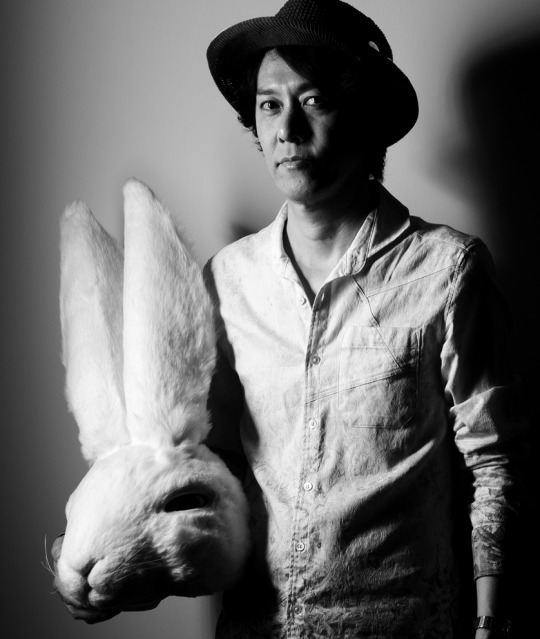
So. Who is this guy with the rabbit? (Picture from his website. Though this is a plain outfit by Ikuhara standards!)
If you were trying to summarise Ikuni’s works... you could probably say something like this: surreal, densely symbolic stories about the difficulties of real human connection. Sort of like the anime version of Lynch. But if that sounds too cerebral, let’s not forget that an episode of Utena involves a character gradually turning into a cow for no particular reason. He’s just as much a goofball who loves to tell lies.
Ikuni came into the business back in the mid eighties, at Toei. [c.f. AN149 for a brief history of Toei!]
So. In the late 70s, Toei had established a powerful niche to themselves in long-running, wildly popular series such as Galaxy Express 999, but most of their work was much less high-profile. Take a glance, see how many of these you recognise - I would guess not many! Hot out of art school, Ikuhara became an assistant director under the wing of Junichi Satō, later well known for shōjo anime such as the avant-garde Princess Tutu (2002-3), or Ojamajo Doremi (1999-2000).
But of course, the most renowned Satō project is Bishōjo Senshi Sailor Moon (1991-7, Pretty Soldier Sailor Moon). Satō directed the first half, and then Ikuhara took the reins for the rest. For Satō it was his debut as a director, I’ll talk more about his tenure on Sailor Moon in just a minute, but first, let’s get a little context about... magical girls!
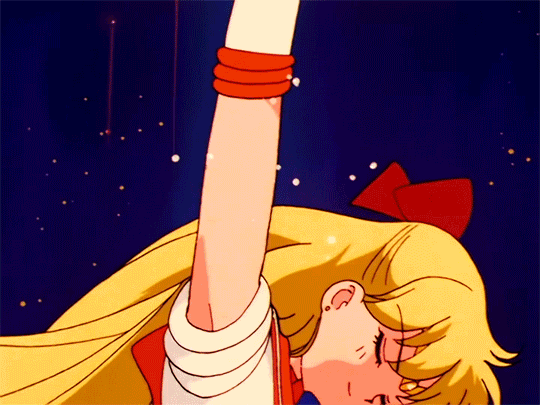
(quick! tell me which sailor this is! you have five seconds)
Magical Girls! 魔法少女 mahō shōjo. An ordinary high school student makes contact with a powerful magical being, who may also be a cute mascot character, and agrees to help. Now she can transform: manifest a stylish outfit, gain suitably themed powers, and fight monsters of the week... but she’s got to maintain a double life as a regular student. The henshin (transformation) sequence itself will usually be an extremely elaborate sequence that is played regularly (a ‘bank’ shot).
By now it’s one of the absolutely central anime archetypes, one people are likely to recognise even if they’ve never watched a magical girl show. It’s been parodied, it’s been genderflipped, it’s spun off a dark otaku-oriented variant.
But it wasn’t always so! Everything must begin somewhere. Very quickly reeling this off then... Osamu Tezuka’s 1953 manga Princess Knight is seen as the earliest proto-magical-girl work; Himitsu no Akko-chan (1962-5) as the earliest true magical girl manga with the elements of the genre, and 1966′s Sally the Witch as the big populariser. In the 70s, Toei started producing them in a big way, known collectively as 魔女っ子 majokko series (‘little witch’).
The actual phrase 魔法少女 mahō shōjo was introduced in 1980 with 魔法少女ララベル Mahō Shōjo Lalabel. With the economic bubble in full swing, other studios started to join the party - notably AshiPro with Minky Momo, and Pierrot, the studio behind epoch-defining megahit Urusei Yatsura, who entered the arena with Creamy Mami, the Magic Angel (1983-4). Why is she creamy? I don’t know, but that’s her stage name as an idol; the manga was designed to promote an actual idol singer Takako Ōta. This business model proved wildly successful, and even today anime production committees usually include record companies who use the show as a vehicle to promote a song or group. Toei no longer had exclusive hold on the matter of girls, magical.
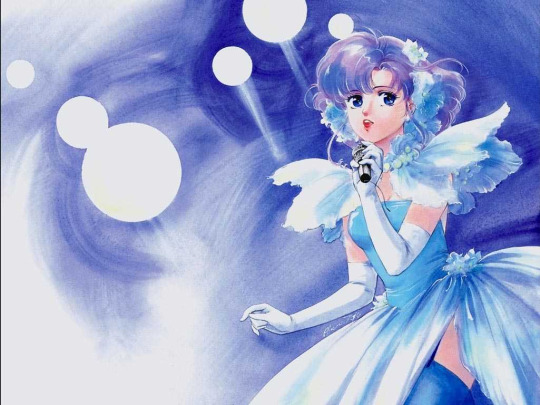
Visually here we’re seeing 80s-style bishōjo, the same as over the fence in sci-fi series such as Macross. Mostly the stories are comedies, following in the footsteps of Urusei Yatsura.
What was missing from the formula at this point? Surprisingly, the henshin sequences! It’s not that magical girls didn’t transform, but they would be more likely to transform into something like an aged-up version of themselves, and the act of transformation wouldn’t be given the same importance. This final ingredient was to be found over in tokusatsu land - Kamen Rider and Super Sentai.
So, that’s where Sailor Moon came in at the beginning of the 90s - first a wildly successful manga by Naoko Takeuchi, and in very short order a TV series at Toei. Takeuchi came up with the idea of fusing the magical girls with sentai: instead of a motorbike-like Rider suit, the girls would get sailor fuku. And that means every magical girl transformation is in a sense a homage to this one.
youtube
Sailor Moon tells the story of a girl called Usagi. She’s a clumsy and forgetful audience-identification character - perhaps even to point of being a Huineng-type character? - but she’s informed by a talking cat that she’s the guardian of Earth, soon to be joined by a number of other girls from her area who are, collectively, the Sailor Guardians (セーラー戦士 sērā senshi). To fight, she activates a magical brooch and, that ^ happens.
Why? Well, the Dark Kingdom is invading! They want to free the villainous Queen Metaria. In past lives the Sailor Guardians fought those guys, and now they need to get back on the job. The forces of the Dark Kingdom (and numerous subsequent enemy factions) arrive in the form of a series of themed villains, much like the villains in a tokusatsu show. Outside of fighting those guys, it’s gentle comedy with a large cast, not so far from the works of Rumiko Takahashi. In fact it’s apparently a fair bit more comedic in tone than the manga, and a chunk of that can be credited to Ikuhara’s influence.
It’s hard to try and summarise the 90s for anime, it wasn’t just one thing. Even as the economic bubble popped, the movies got increasingly ambitious, reaching for more complex emotions and darker themes with incredibly complex animation to match. And to a certain extent, that was also true on TV, by which I mean “Evangelion happened”. But it was also an age of a return to more limited animation. If you wanted to make a TV anime, you had to be smart about using all the tools you could to cut corners. You could keep a bank of reused shots, or for a joke, transform a character into a much simpler caricatured design with more limited animation. At the same time, photography was getting more advanced, and animation techniques were getting more sophisticated.
Even so, a lot of the credit for the art of working effectively in limited animation goes way back to Osamu Dezaki, who back in the 60s and 70s established many of the iconic ‘anime’ techniques. I’ve written about him before back on Animation Night 95, but as much as that covers the history, it doesn’t say a lot about Dezaki’s style. So let me pull in this video, which will helpfully illustrate the important examples...
youtube
The relevant period is when Dezaki directed on Aim for the Ace! (エースをねらえ! Ēsu o Nerae!) - where, in contrast to his earlier work which was comparatively cinematic, he started to push in a more theatrical, abstracted direction, prioritising conveying emotion over realism. Still frames (with the famous ‘postcard memory’ effect), simplified background details framed to draw attention to the important stuff, repeating an important shot multiple times - oh, that’s just Utena, huh? And while Dezaki influenced just about everyone, but for Ikuhara, he’s a massive touchpoint.
Designs were also changing - in contrast to the rounded bishōjo of the 80s came more angular and blocky designs. Take Slayers for example:

Hold onto that thought because we’re going to talk about Utena in a minute. Sailor Moon didn’t go quite that far, but Kazuko Tadano’s designs were very effective in conveying a lot of appeal in quite simple shapes. Usagi in particular has an instantly recognisable hairstyle. But it’s also a style very amenable to simplification.
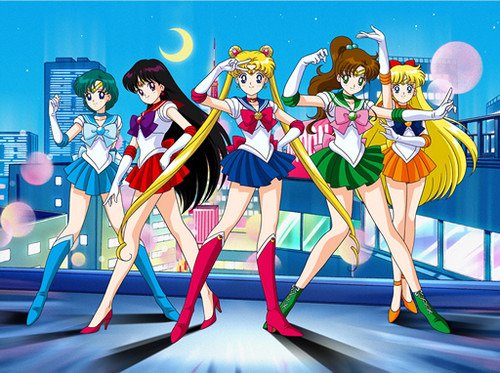
TV anime in this period ran long. Nowadays, the norm is one cours (‘cour’ if you’re not feeling pedantic) of 12-13 episodes, sometimes not even that. Back then you could easily see counts in the 50s or even hundreds. Such is true of Sailor Moon: crazy popular in both Japan and, in its heavily localised dub, America, and with a premise flexible enough to run for years. In the end it racked up some 200 episodes and several movies.
The Ikuhara period starts with the Sailor Moon R movie in 1993, then the series proper starting mid Sailor Moon R and then Sailor Moon S in 1994. Not sure which episode he took over, but S begins at 90. This is a post about Ikuhara (no, really!) so we should ask, how did Sailor Moon change once he took the reins? Let’s have a look at some of his favourite themes, as they appear in the Sailor Moon R movie, based on his own notes...

Lesbians - Not so much in the R movie, but once S gets going... big controversy! Sailors Uranus and Neptune were a couple whose dynamic was one of the most popular in the show, but this would be heavily censored in nearly every localisation, notably the American one which made them cousins.
Flower imagery - Ikuhara decided to set his first project as director in a botanical garden, naturally.
Lost connections, the distance between people - to quote the linked blog...
Ikuhara compares the reunion between Fiore and Mamoru with that of being stuck on a train in-between stations when suddenly you notice you’re standing next to an old friend you haven’t seen in years.
At first you’re both excited to see each other again and kill the time by catching up on each other’s lives. But eventually you run out of things to say, and the conversation just kind of dies off, leaving you both standing there in awkward silence.
Creative editing, use of music - 18 second long scene of Tuxedo Mask getting stabbed? Musically timed fight? Mm.
Darker themes - let’s watch the girls incinerate a field of flower monsters! At one point Usagi would nearly die! Ikuhara tried to keep it ‘fun’ and lighthearted, but just couldn’t do it, he says. Nothing on the level of where his later work would go, but definitely harsher than your average episode.
Vaguely hinting that some element is key to understanding everything, and then refusing to elaborate further - oh yes.
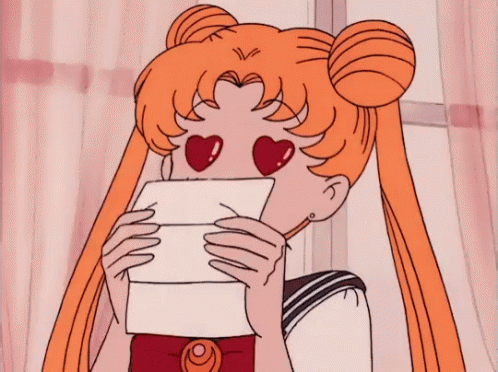
Which isn’t to say that Ikuhara’s Sailor Moon instantly became Utena. Rather, the seeds of his interests as a director, the sort of emotional arcs he’d like to portray, were there. I regret that I can’t really comment in much detail on what Ikuhara did in his actual run on the TV series - I’m sure I have some big Sailor Moon fans here who could fill me in and tell me if I’ve described anything wrong.
Working on Sailor Moon, in any case, also got Ikuhara used to technical elements that would become part of his stylistic fingerprint. We mentioned the transformation sequence, the elaborate bank shot with accompanying music that would recur in nearly every episode. I am less sure about other Dezaki-esque elements, like jokes based on repeating the same sequence with minor variations.
Eventually, Ikuhara’s run on Sailor Moon would come to an end. The final arc of the show saw the Sailor Guardians facing... themselves, from a distant bad future. But for that final season, Ikuhara had already stepped down. Where did he go...?
You see, Ikuhara chafed under the creative restrictions placed on him by Toei. Turning down an offer from Anno to work on Eva(!), he set off to found his own group, Be-Papas, along with...
the famous shōjo manga artist Chiho Saito, animator Shinya Hasegawa, writer Yōji Enokido, and producer Yuuichiro Okuro
and before long also recruiting composer J.A. Seazer, known for his work with avant-garde dramatist-filmmaker-writer-poet Shūji Terayama - another big influence on Ikuni, incidentally. What did Be-Papas make? Just one anime, after which they disbanded. That anime was... Albert Ei-
youtube
That anime was Utena.
Oh man. This is the one.
少女革命ウテナ - Shōjo Kakumei Utena. In English, Revolutionary Girl Utena. Now the time has finally come to write about it, I’m nervous. Could I possibly do justice to Utena in a single blog post? Is that why I spent so long writing about Sailor Moon?
Let’s start with the aesthetic: French Revolution-esque outfits that would be comfortable in Rose of Versailles. A school made of white stone; architecture that is strange, avant-garde. Roses. So many roses oh my fucking god. It draws heavily on the Takarazuka Revue, which I wrote about previously on Animation Night 92 in the context of Ikuhara’s protege Tomohiro Furukawa.
Utena is about a girl called (wait for it) Utena, who attends a school of sorts called Ohtori Academy. But it’s a school only in a fairly abstract sense - it’s more like a palace. She wears a distinctive masculine uniform, and shortly after transferring in, discovers a mysterious underground duelling society who go to a strange abstract battle arena outside of school hours. There, they attempt to strike the rose from the other duellist. The winner of the duel gains custody of Anthy Himemiya, the ‘Rose Bride’. At some point, whoever possesses Anthy will gain the nebulous power to ‘revolutionise the world’. With me so far?

Utena walks in and immediately wins her first duel, establishing an initially frosty relationship with Anthy. But the White Rose duellists won’t take this lying down. Over the first series of episodes, we learn about each of the duellists and their motivating conflicts, culminating in an attempt to defeat Utena. (She walks up the stairs every time.) They lose every time, but the point isn’t really about whether Utena will win or not - it’s about introducing us to a collection of fucked up guys, and then making them even more fucked up.
But it’s not all high drama. A lot of Utena is just straight-up antics, which is to say, just about any time Nanami is on the screen. There’s a greek chorus of shadow girls who comment on the events of the episode. The broad strokes are hard to miss, but the subtler, more obtuse stuff is the sort of thing that can get you into an almost endless rabbit hole of analysis. Don’t take things too literally! You could probably call it at least a little Brechtian in how much it foregrounds its own artifice.
After Utena’s defeated just about everyone at the White Rose, the Black Rose arc introduces a new element. Now, characters from beyond the duelling circle will go down an elevator to guy who renders a fucked up sort of anti-therapy which will motivate them give into their worst impulses and have a go at Utena. Utena, meanwhile, is harbouring a complex where she needs to live up to an ideal of fairytale prince following an incident from her childhood - and oblivious to what’s actually going on with Anthy.
Then at last Anthy’s brother Akio shows up - the actual prince from the upside-down castle in the sky that represents the power to revolutionise the world, and the architect of the monstrous system. It turns out he’s been incesting Anthy, that she’s complicit in all his shenanigans (guess who was behind the Black Rose thing). Moreover, Utena is pulled in to Akio’s orbit, an ugly, abusive relationship... that is conveyed mostly through visual metaphors involving cars.
The finale is... complicated to explain. But it gives us one of the most iconic pieces of cinematic lesbianism ever animated, as Utena reaches for Anthy, refusing to be pushed away (by stabbing) or let Anthy remain in her state of self-inflicted pain, and they are able to escape the academy and its system, at the cost of being separated. What future they have outside the academy is left unspoken...
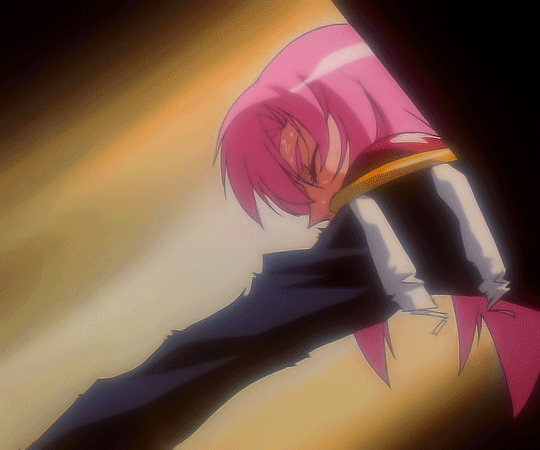
And that’s just scratching the surface. If you ask the hardcore Utena fan, just about every element of every shot is dripping with meaning. You can’t take everything too literally, but you definitely have to take some portion of it literally or you don’t have a story and characters at all.
Visually, the characters in Utena are designed by Shinya Hasegawa - and as much as they are recognisably ‘90s’, they really push it. People are long and faces - noses and chins especially - are pointy. Characters tend to be reserved and stoic in their facial expressions, unless they’re Nanami, in which case all bets are off. Animation-wise, JC Staff did the work under Be-Papas’s direction - and as much as it uses limited animation for effect, it’s really got the goods, especially in the duel sequences and the bank shots (Utena climbing the stairs? Not CG!).
Did you know Yoh Yoshinari was on it? I didn’t until today! So too was Mamoru Hosoda.
Remarkably for such a deliberately challenging show Utena was pretty successful! This was the era between Eva and Lain: it was an excellent time to be making something really experimental and push those genre boundaries. (One thing I don’t really know is how Utena got funded in the first place, but all the big names attached to the project probably gave them some pull.)
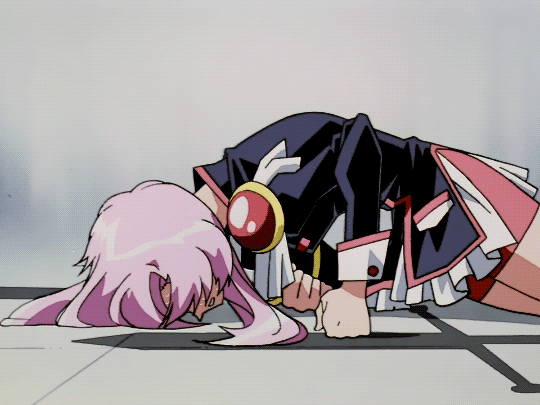
Alongside the anime came a manga by Saito - but neither is really an adaptation of the other, they’re just two different interpretations of the same general concept and premise, produced at the same time. And in fact, Ikuhara and Saito clashed heavily over the direction of the series, particularly in regards to whether the relationship between Utena and Anthy should be presented as romantic. Saito did not believe that shōjo audiences would be on board with the yuri, but Ikuhara refused to back down. (Saito eventually changed her mind.)
With all this success, they went ahead to make a movie. Now, usually a compilation movie of a successful TV series will cut out down the story to fit the runtime, reanimate a few scenes and call it a day. But this would be all but impossible with Utena, which is so tied to its episodic structure and use of repetition. And in any case, Be-Papas had bigger ambitions!
The film would be titled 少女革命ウテナ アドゥレセンス黙示録 Shōjo Kakumei Utena: Aduresensu Mokushiroku, literally Revolutionary Girl Utena: Adolescence Apocalypse, though in English it’s usually given the shorter title Adolescence of Utena. It is kinda sorta a condensed version of the series at first... and then in the latter half it goes completely off the rails. This time Akio is long dead. And he’s not the only one! It ends with this absolutely nuts sequence where Utena turns into a car to drive Anthy out of the academy, pursued by Shiori, who also turns into a car. I still can’t say I really understand it, or how it relates to the ‘car is a rape metaphor’ role in the TV series? But it looks beautiful.
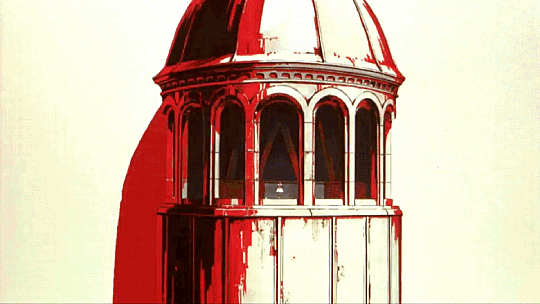
Compared to the series, the movie features the expected higher drawing counts and flashier animation... but the really novel aspect is the architecture. This movie goes absolutely wild with it: the Ohtori Academy this time is far stranger and more intricate, looking less like a regular old European palace and more like something dreamed up by the Russian avant-garde.
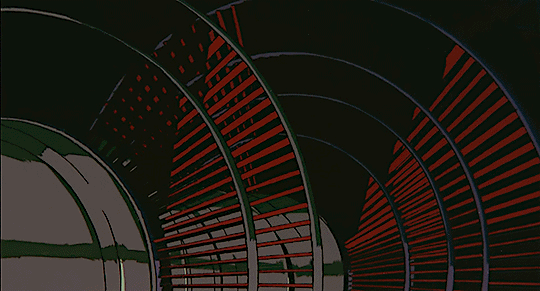
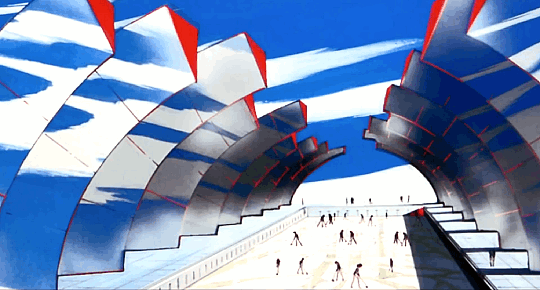

It’s less of a summary of Utena and more of a companion piece. Seen on its own by someone who’s not familiar with either... I’m not sure how it would come across! Maybe you’ll just think I’m insane. Maybe you’ll be right.
So, some 3000 words into this post, I’ve finally told you the first movie we’ll be watching! That’s right: we’re going to jump in at the deep end and enjoy Adolescence of Utena. You don’t need to have seen the series.
After Adolescence, Be-Papas disbanded, as if following Monsieur Dupont’s injunction that radical groups must exist for a single purpose and then disband. Ikuhara left anime for a long time, like twelve years. He wasn’t entirely cut out from the industry, occasionally dropping in to storyboard an episode or two (for example, Episode 2 of Diebuster, or the OP to yuri series Aoi Hana). But for the most part, he turned his attentions to other mediums.
In that time he published a shōjo manga, which was poorly received for being a lot more conventional than Utena; he also wrote a novel called Schell Bullet which, get a load of this...
As a result of gene manipulation, society is segregated by genes into "Majors" – intersex humans who maintain a monopoly on stronger genetic material – and lesser dual-sex "Minors". (Ikuhara stated that he chose to make the Majors intersex because he wished to create "a race which combines the good parts of both women and men."[1]) Protagonist Ors Break is hired by the intergalactic trading company Balt Liner Corporation to pilot a schell, a bio-organic mecha, by claiming to be a Major. When the truth of his Minor status is revealed, he comes to an agreement with his superior, a Major named Delbee Ibus, to continue working for the organization.[1][2]
...and another serial novel called Nokomono to Hanayome, described as ‘Lolita hardboiled’ (I believe as in ‘Elegant Gothic’ rather than as in ‘Nabokov’s novel’). This last was a precursor to Penguindrum - animal costumes, the a story about the 1995 Tokyo sarin gas attacks.
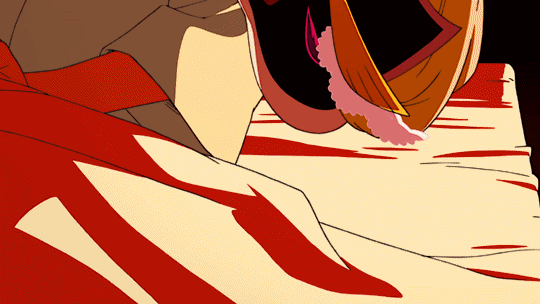
In 2011, Ikuhara came back to anime. Why? And why did he leave in the first place? itsamystery.jpg. In any case, his new project was... Mawaru Penguindrum. It’s about, I guess you might say, the abandoned children of cultists who connect to a supernatural penguin being through a hat. But honestly it’s even tougher to attempt to summarise than Utena. There’s a “child broiler” involved. That’s just the start. And this post is already very long.
So, it’s time to split it. You’ll be able to read more about Penguindrum tomorrow (or later today, if you’re also staying up insanely late in the UK).
Animation Night 155, in its cosy new Sunday timeslot, will be running (if all goes according to plan) at 8pm UK time. That’s about 13 hours from the time of this post. The plan will be to watch Adolescence of Utena and the two movies of Re:cyle of the Penguindrum, for a total of about five and a half hours. (Sorry Sailor Moon fans! I’d really like to squeeze in the R movie too, but I underestimate how long Penguindrum is in movie form. We’ll find another day to do Sailor Moon though!)
If you’ve read all this so far, thanks so much! I’ve wanted to do a proper Animation Night on Ikuhara for ages, and there’s so much I can write about. So far it’s all history, but we wanna do some analysis too. For now... hold on tight.
103 notes
·
View notes
Photo





hna 10.02.11
#himitsu no arashi chan#ninomiya kazunari#I agree with younha I like his face#dumbfounded nino is the cutest#my edits
82 notes
·
View notes
Photo









Jun: *DadJun mode* Don’t bully your mom, Sho
Sho: *avert the eyes* I am not hearing
Jun: Hey, do you understand?
Sho: yeah...I understand *pout*
#arashi#sakuraisho#matsumotojun#dadjun#himitsu no arashi chan#Sho chan is sooo cute#No violent Sho#Sho's mom surely have a hard time LOL#look the pouted mouth
2 notes
·
View notes
Text

🎥: -Lady Gif SakuMiya-
#arashi#ninomiya kazunari#jun matsumoto#ohno satoshi#sakurai sho#aiba masaki#himitsu no arashi chan#pair#meme#funny#sakuraiba#WorldArashians5x20#ArashianForLife#嵐#大野智#櫻井翔#相葉雅紀#二宮和也#松本潤
3 notes
·
View notes
Photo








ひみつの嵐ちゃん! 10.05.2012
#Ohno that face is perfect#little cutie#himitsu no arashi chan#arashi#sakurai sho#onho satoshi#yuka#keeksgifs#poor translation by me
48 notes
·
View notes
Video
tumblr
20 notes
·
View notes
Photo
Oh-chan may be 39 now but somehow still emitting pure joy aura ☺️






Ohmiya in the opening of Mago Mago Arashi Epi 18. Oh-chan epic! (.◜ω◝.)
#reblog#throwback#arashi#ohno satoshi#ninomiya kazunari#himitsu no arashi chan#mago mago arashi#mma#hna#ohmiya
600 notes
·
View notes
Photo










└ Arashi Fashion Parade: Sea of Calm x Storm of Emotions~
Cr: Himitsu no Arashi-chan Mannequn 5 SP1 29.04.2010
#arashi#himitsu no arashi chan#ohno satoshi#sakurai sho#aiba masaki#ninomiya kazunari#matsumoto jun#the good old days of mannequin five SPs#ahhh~ miss this corner#had such a laugh rewatching this and recapping the memories#no spoilers for those may not have watched#but honestly please do#dgifs#in a queue
91 notes
·
View notes
Photo









The Headband Story
#Arashi#himitsu no arashi chan#matsumoto jun#are you happy? concert#making of#ninomiya kazunari#sakurai sho#I randomly came across Jun's today and wondered if anyone else has noticed this yet???#Or if anyone else has ran across any other sightings yet#it is quite interesting
94 notes
·
View notes
Text
Propaganda Tags Used
Not tagging every alternate title and the like on propaganda posts, so here's a list of the tags I'm using for each series, for easier browsing :P
(25/02/24: updated to include season 3)
(10/10/24: due to tumblr's pesky 100 link limit, check the pinned for tags past season 3)
Season 3 Contestants:
2DK, G-Pen, Aftertime. || A Kiss and a White Lily || A Lady's Table || Aoi Hana || Ayaka is in Love with Hiroko! || Because You Are a Red Rose || Blooming Sequence || Composing Spring in This Room Where Cherry Blossoms Bloom || Dark Forest, White Road || Destroy It All and Love Me In Hell || Handsome Girl and Sheltered Girl || I Married My Best Friend to Shut My Parents Up || I'm Not Cut Out to Be a Princess, so I'll Elope With the Villainess! || Indigo Blue || Kakegurui || Kanojo ni Naritai Kimi to Boku || Mahou Josei Chimaka || Makoto no Momoka || Maria-sama ga Miteru || Muted || Netsu wo Obiru Veil || Ohana Holoholo || Sakura Namiki || Savior || Serendipity || Soulmate || That Time I Was Blackmailed By The Class's Green Tea Bitch || The Girl That Can't Get a Girlfriend || The Moon On A Rainy Night || To Die in June || You Are My Angela || Yuki and the Authoress
Season 2 Contestants:
2DK, G-Pen, Alarm Clock || Always Human || An Absurd Relationship || Asagao to Kase-san || Asumi-chan is interested in lesbian brothels || Can't Defy the Lonely Girl || Cirque Arachne || Even the introverted gals wanna get out there! || Fly By || Futari Escape || Gunjou || Hana to Hoshi || Hard Lacquer || Her Tale of Shim Chong || Himitsu no Hanazono || I Love Amy || I See You, Aizawa-san! || I won 300 million yen in a lottery so I started raising a freeloader pretty girl || Lonely Wolf, Lonely Sheep || Love My Life || Mai no Mushigurashi || Nomura Nao to Kyougaku Hina || Pink Ribbon || Sexual Education 120% || Tamen de Gushi || Teppuu || The Ends of a Dream || The guy she was interested in wasn't a guy at all || There's weird voices coming from the room next door! || Yoru to Umi || Young Ladies Don't Play Fighting Games || Yuri Espoir
Season 1 Contestants:
A Monster Wants to Eat Me || Black & White: Tough Love in the Office || Bloom into You || The Blue Star On That Day || Can I kiss you? || Catch These Hands || Doughnuts under a Crescent Moon || Goodbye My Rose Garden || Hana ni Arashi || Hanamonogatari || Hello, Melancholic! || How Do I Get Together with My Childhood Friend♀️? || How Do We Relationship? || I'm in Love with the Villainess || It would be great if you didn't exist! || Liar Satsuki Can See Death || Love Allergy Syndrome || Moonlight Flowers || My wish is to fall in love until you die || Not So Shoujo Love Story || Rock it, GiRL!! || Run Away With Me, Girl || Octave || Oniisama e... || Otherside Picnic || Pietà || Sasameki Koto || She loves to cook, and she loves to eat || Shiroi Heya no Futari || SHWD || Still Sick || Yuri Kuma Arashi

27 notes
·
View notes
Photo










2010.07.22 Perfume Himitsu no Arashi-chan! V.I.P. Room
Google Drive
37 notes
·
View notes
Photo
Wet arashi... im sorry for the pun unintented








モテ嵐!ダメ嵐!~ ひみつの嵐ちゃん
531 notes
·
View notes

